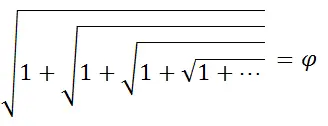Copyright © Had2Know 2010-2025. All Rights Reserved.
Terms of Use | Privacy Policy | Contact
Site Design by E. Emerson
Golden Ratio Calculator
The golden ratio is so-called because the ancient Greeks found rectangles more aesthetically pleasing when their side lengths were in a ratio of 1:(1 + √5)/2, or approximately 1:1.618034.
The number (1 + √5)/2 is often called the golden section and denoted by φ.
The constant φ appears in a number of algebraic, arithmetic, and geometric relations. For example, the continued fraction

converges to φ. The continued radical

also converges to φ. These two arithmetic expressions can be resolved by solving the algebraic equations
x = 1 + 1/x and x = √x+1 .
The only positively valued solution to these two equations is x = φ. (Transform the expressions into quadratic equations and use the quadratic formula.) The golden section is also the limiting ratio of consecutive Fibonacci numbers. For example,
3/2 = 1.5
5/3 = 1.6
8/5 = 1.6
13/8 = 1.625
⋮
987/610 = 1.6180323, etc.
To understand φ geometrically, suppose you have a rectangle whose sides are in a ratio of 1:φ. When you cut a perfect square from the rectangle, the remaining rectangle is also a golden rectangle. If you repeat the process over and over, you obtain the pattern shown on the left:

width = length/φ
length = width × φ
© Had2Know 2010
